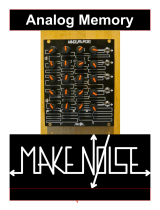
8
Overview
Pressure Points is a controller in which 1 of 4 sets of 3 tuned voltages are selected by touching the corresponding
printed copper wire at the bottom of the instrument. Touching Pressure Points, you become part of the circuit,
generating a gate signal (Gate OUT), a control signal proportional to the amount of pressure applied (Press OUT) and
activating the corresponding Stage. The Tuned Voltages for the activated Stage appear at their respective X, Y and Z
OUTs. In this way, Pressure Points is like an analog sequencer that is played by hand.
Stages can also be selected via clock inputs with the expander module, BRAINS
(http://www.makenoisemusic.com/brains.shtml)."
2 pots allow the circuit to be adjusted for desired playing response. Up to 4 of these modules may be CHAINed together
to create controllers of varying size and complexity. The Gate and Press OUTS are normalized to their respective
Combined BUS which is output at the last Gate or Press OUT in the CHAIN.
Playing
The Pressure Points requires the development of a technique, and CLEAN, BARE Hands. Touching the upper-most portion of the
touchplate with as little of your nger as needed to activate the circuit, will generate a Gate and select the corresponding Stage.
The 3 Tuned Voltages, as set by the column of 3 Potentiometers above the touchplate, appear at their respective X, Y and Z
OUTs. Laying more of your nger down on the touchplate, and pressing harder, will generate a pressure control voltage
proportional to amount esh mashed into the copper of the touchplate. Pressing harder, more of your esh comes into contact
with a sensitive point in the circuit, hence the name Pressure Points. Set the Touch Sensitivity Adjustment Potentiometer further
CW so that you may slide eortlessly and quickly from stage to stage, or set it more CCW when you want greater control over
the Press Control Signal. If you cannot obtain the desired response, you might need to adjust the internal Digit Trimmer to
compensate for size & moisture of your digits as well as playing technique and style of installation (vertical, horizontal, angled).
This requires a trimmer tool or jeweler's screwdriver, and access to the module from the right side, where the Digit Trimmer is
located on the circuit board. Please turn the power for Pressure Points OFF while adjusting the trimmer. Default setting for Digit
Trimmer is 40% CW. Setting more CW will increase sensitivity for smaller and/ or dryer ngers, or for Vertical installations. Due to
the complex nature of the human nger, you will need to experiment with settings to achieve the best playing response.
CHAINing Pressure Points:
Requires the 10 PIN CHAIN Cable, which is available where ever Pressure Points is sold, and the proper setting of jumpers on the
modules to be CHAINed. Refer to the drawing on opposing page. All modules in the CHAIN will need to be connected to the
power supply via their supplied power cables.
CARE for Pressure Points like you would most instruments, keeping it clean and avoiding the destruction of it's playing surface.
Use a soft, dry cloth such as the 3M Microber Lens Cleaning Cloth.
















